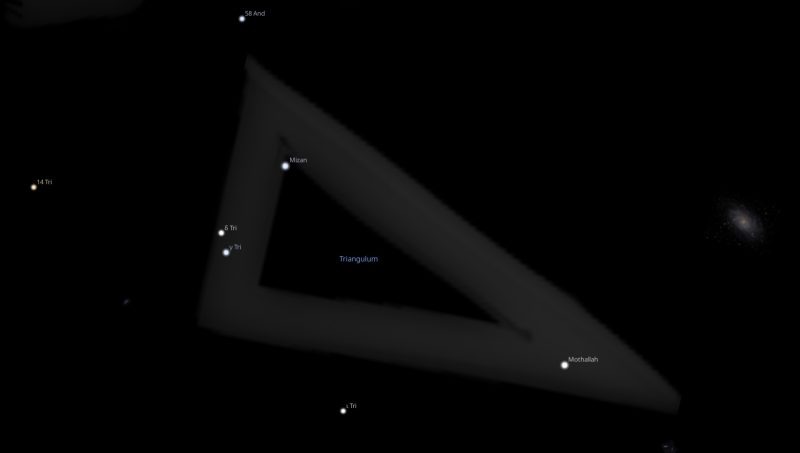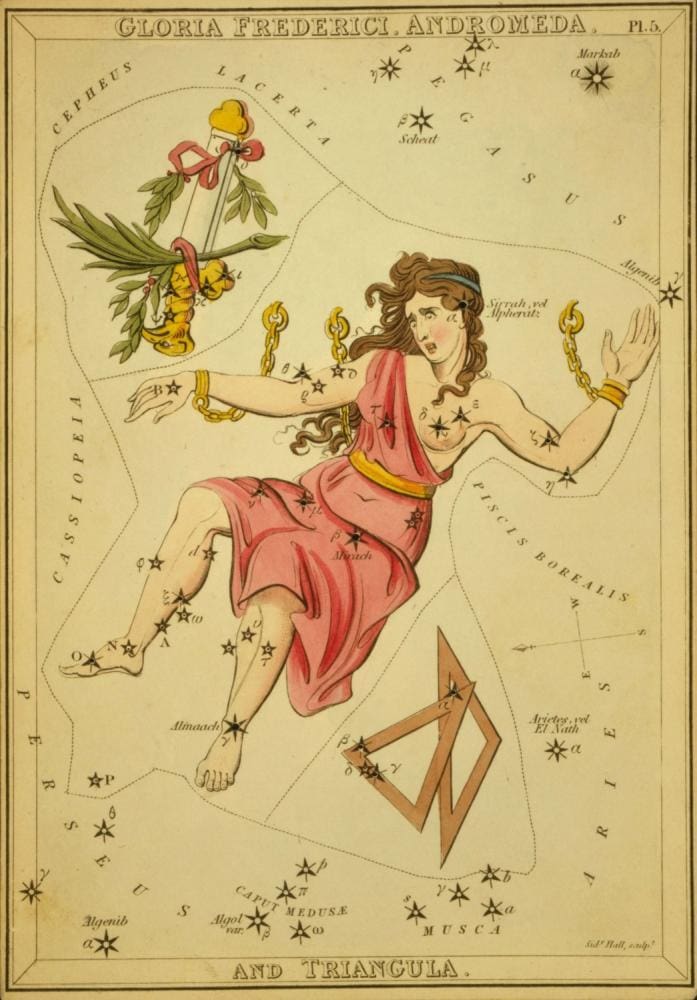FIXED STARS: Major Stars | 1000+ Stars | Constellations | About
Constellation Triangulum The Triangle is a northern constellation bordering Aries, Pisces, Perseus, Andromeda and the obsolete constellation Musca Borealis.Triangulum is one of the 48 constellations listed by Ptolemy in the 2nd century and remains one of the 88 modern constellations. It spans 9 degrees of the zodiac in the Sign of Taurus.
Abbreviation: Tri
Genitive: Trianguli
Triangulum Constellation Stars
| 2000 | 2050 | Star | Name | Sp. Class | Mag. | Orb |
|---|---|---|---|---|---|---|
| 06♉52 | 07♉34 | α Tri | Mothallah | F6 | 3.42 | 1°40′ |
| 11♉12 | 11♉54 | ι Tri | F5 | 4.94 | 1°00′ | |
| 12♉21 | 13♉04 | β Tri | Mizan | A5 | 3.00 | 1°50′ |
| 13♉31 | 14♉13 | γ Tri | A1 | 4.03 | 1°20′ | |
| 13♉37 | 14♉19 | δ Tri | G0 | 4.84 | 1°00′ |
β Tri is named Mizan. α and β were called Al Mīzān, which is Arabic for “The Scale Beam”. [2]
Triangulum Astrology
Robson
Legend. Triangulum is said to have been placed in the heavens by Jupiter at the request of Ceres who asked that the shape of her island Sicily might be represented amongst the stars.
Influence. According to Ptolemy it is like Mercury. It is said to give a just, companionable, truthful, righteous and benevolent nature, with interest in architecture and Freemasonry. [3]
Noonan
Now called Triangulum (Tri), the stars of this constellation are as Mercury according to Ptolemy. It presages events concerning rivers and streams, and also as regards the weather. It is a generally fortunate constellation, indicating a benevolent and truthful nature.
Mothallah has the planetary nature of Mercury and indicates those of a just nature and those whose living is made in the legal profession. [4]
Allen
Triangulum always qualified as major till the Lesser Triangle was discarded. It lies just south from γ Andromedae on the edge of the Milky Way, and although small and faint, is one of the old constellations evidently more noticed by the ancients than by us. They drew it as equilateral, but now it is a scalene figure, β, δ, γ at the base and α at the vertex.
Transcribed by Cicero and Hyginus as Deltoton, it became Deltotum with the Romans, as well as with astronomers to the 17th century. Naturally it also was Delta, and so, associated with Egypt and the Nile, became Aegyptus, Nilus, Nili Domum, the Home of the Nile, which originally was Nili Donum, the Gift of the Nile, from Herodotus’ ποταμοῦ δῶρον, “the river’s gift.”
Τρίγωνον, used by Hipparchos and Ptolemy, became Trigonum with Vitruvius, and Trigonus with Manilius, translated Trigon by Creech. Tricuspis, Three-pointed, and Triquetrum, the Trinal Aspect of astrology, are found for it.
Its titles Sicilia, Trinacria, and Triquetra are those of the ancients for the similarly shaped island of Sicily, — that Ceres had begged of Jove might be reproduced in the sky, — triangular from its three promontories, Lilybaeum, Pelorus, and Pachynus, and at times identified with the mythical Thrinakia of the Odyssey, the pasture-ground of the Oxen of the Sun, that Gower called Mela’s Holy Ox-land. In modern days it has been noted as the site of the famous Palermo Observatory.
It was here that was discovered by Piazzi, on the first New Year Day of the present century, the first minor planet, which he named Ceres Ferdinandea in joint honor of the patron goddess of the island and of his king, the Bourbon Ferdinand of Naples; but the adjective has been dropped by astronomers as not conforming to their rule of mythological nomenclature for the planets, — a rule, however, much deviated from in recent times in the naming of these little bodies. Perhaps the astronomers have exhausted their classical dictionaries! It was found as an 8th‑magnitude star — Flammarion says as a comet — between Aries and Taurus, coincidentally not far from our Triangulum, the ancient Sicilia; but it was little imagined at the time that 433 similar bodies would be found in the next ninety-seven years, more than 150 of them since 1892, and all but seven of these last by photography,2 then an unknown art.
The Arabians translated our title as Al Muthallath, variously seen in Western usage as Almutallath, Almutaleh, Almutlato, Mutlat, Mutlaton, Mutlathum, Mutlathun, and Mutlatun, with probably still other similarly degenerated forms of the original.
The Jews are said to have known it as Shālīsh, from the name of an instrument of music of triangular shape, or with three cords, mentioned in the 1st Book of Samuel, xviii.6. This same figure, for the three bright stars of Aries, has already been noticed at γ of that constellation.
Heis enumerates here 30 naked-eye components, but Argelander only 15.
The Chinese asterism Tsien Ta Tseang, Heaven’s Great General, included this with λ of Andromeda and the stars of the Smaller Triangle. [2]
References
- A Dictionary of Modern Star Names, Kunitzch, Smart, 2006, p.55.
- Star Names: Their Lore and Meaning, Richard H. Allen, 1889, p.414-416.
- Fixed Stars and Constellations in Astrology, Vivian E. Robson, 1923, p.64.
- Fixed Stars and Judicial Astrology, George Noonan, 1990. p.32.

